Battle Of Midway
 From Conservapedia
From Conservapedia 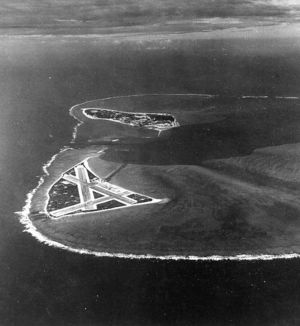
The Battle of Midway, fought near the Central Pacific island of Midway on June 4–7, 1942, is considered the decisive battle of the war in the Pacific Ocean. Before this battle the Japanese were on the offensive, capturing territory throughout Asia and the Pacific. By their attack, the Japanese had planned to capture Midway to use as an advance base, as well as to entrap and destroy the U.S. Pacific Fleet. Because of communication intelligence successes, the U.S. Pacific Fleet surprised the Japanese forces, sinking the four Japanese carriers that had attacked Pearl Harbor only six months before, while only losing of one carrier. After Midway, the Americans and their Allies took the offensive in the Pacific.
Contents
- 1 Midway Atoll
- 2 Prelude
- 2.1 Early intelligence
- 2.2 Coral Sea
- 2.3 "AF"
- 3 Japanese plan
- 3.1 The Doolittle Raid
- 4 American plans
- 5 Departure to battle
- 6 The Battle
- 6.1 June 4, 1942
- 6.2 June 5, 1942
- 6.3 June 6, 1942
- 7 Aftermath and Significance of the Battle
- 8 References
Midway Atoll[edit]
Midway is a small atoll nearly half-way across the Pacific, the westernmost inhabited member of the Hawaiian Island chain. Its two major islands, Sand and Eastern, have a combined area of only a few square miles. They are densely populated by several bird species, of which the most abundant is the Laysan Albatross, popularly nicknamed the "Gooney Bird".
First visited in 1859, Midway formally became a United States possession in 1867. A trans-pacific cable station was established there in 1903. In 1935, Pan American Airways built a way station on Sand Island to support its new seaplane route between the U.S. and Asia. Midway was recommended as a patrol plane and submarine base in a 1938-39 study of national defense needs, and construction of a U.S. Navy base began soon thereafter. This included a seaplane hangar and other facilities on Sand Island and an airfield on the smaller Eastern Island.
The new base was bombarded by two Japanese Destroyers on December 7, 1941, causing damage to some buildings and destroying one patrol plane. With the fall of Wake Island later in the month, Midway became the westernmost U.S. outpost in the Central Pacific. Land-based bombers and fighters were stationed on Eastern Island. U.S. Marines provided defensive artillery and infantry. Operating from Sand Island and the atoll's lagoon, PBY "Catalina" seaplanes actively patrolled toward the Japanese-held Marshall Islands and Wake, checking on enemy activities and guarding against further enemy attacks on Hawaii. There were occasional clashes when planes from Midway and those from the Japanese islands met over the Pacific.
Prelude[edit]
Following the outbreak of the Pacific War in December 1941, the Japanese armed forces conducted military operations against U.S., British Commonwealth, and Dutch possessions in the Pacific and Southeast Asia. The first phase of these operations, which was the seizure of Malaysia, Singapore, the Dutch East Indies, the Philippines, and various island groups in the central and western Pacific, was virtually complete by March 1942. The second phase, initiated by Japanese Imperial Headquarters on January 23, was designed to isolate and neutralize Australia and India. In the Pacific, this plan envisioned the seizure of bases in Papua/New Guinea and the Solomon Islands, which would be used to support future operations against New Caledonia, Fiji, and Samoa. By early March, with the seizure of Lae and Salamaua, the entire north coast of Papua/New Guinea had fallen to Japanese forces who were planning for an amphibious invasion of Port Moresby.
Early intelligence[edit]
By this time, two secure American naval intelligence centers were in operation in the Pacific: one in Melbourne, Australia, and another at Pearl Harbor ("Hypo"). A third, at Corregidor ("Cast"), was rapidly disintegrating under Japanese air and artillery attacks on the island. Its cryptanalysts and equipment were in the process of evacuation to Melbourne. These facilities intercepted Japanese radio communications and, through traffic analysis and codebreaking, uncovered the location of major fleet units and shore based air forces. More importantly, by translating messages and studying operational patterns, Melbourne and Hypo predicted future Japanese operations. The intelligence centers provided their analysis, through daily communications intelligence (COMINT) briefings and warning reports, to senior American commanders, including Commander in Chief, U.S. Fleet, Admiral Ernest J. King, and Commander in Chief, Pacific Fleet, Admiral Chester W. Nimitz.
Coral Sea[edit]
In early March, the Japanese postponed their planned seizure of Port Moresby because of previous events. An American carrier raid on Japanese shipping at Lae and Salamaua on the 10th, along with a previously unsuccessful attempt to attack Rabaul on February 20, had demonstrated to Commander in Chief, Fourth Fleet (Admiral Shigeyoshi Inouye), that Japanese were not assured of air superiority in the region. It was not until early May, when Admiral Inouye had three carriers for operations, that the invasion could begin. On May 7–8, the first carrier battle of the war took place in the Coral Sea. Each side had a carrier damaged, while the American lost the carrier USS Lexington and the Japanese lost the light carrier Shoho. More important the Japanese broke off their invasion attempt. Significantly, American cryptanalysts had provided crucial order of battle and operational communications intelligence to the Allied commanders in the South Pacific.
"AF"[edit]
In addition to this advance toward Port Moresby, evidence that Japan was intent on expanding east of the Marshall Islands appeared in COMINT in early 1942. Land-based air units and equipment began appearing in message traffic to and from the Marshall Islands and the Mandates. On March 4, the designator "AF" began appearing in partially decoded messages. Then, on March 5 Japanese seaplanes, refueled from a submarine at French Frigate Shoals to the east of Midway, conducted a small armed reconnaissance mission over Oahu. Finally, on March 13, American cryptanalysts got the break they were looking for. Acting on a hunch that "AF" was Midway, they asked the radiomen there to send an open-air message indicating something was wrong with their water supply; the Japanese sent a message in turn indicating the "problem" with "AF". The result was both the breaking of the Japanese Navy's General-Purpose Code (JN 25) and the identification of "AF" as Midway Island.
Japanese plan[edit]
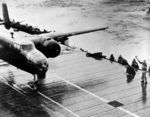
On April 16, after several months of discussion, Commander in Chief, Combined Fleet, Admiral Isoroku Yamamoto, convinced the Imperial General Staff to agree to his Midway and Aleutians strategy for the summer. In Admiral Yamamoto's view, the capture of Midway Island would allow Japan to pursue its Asian policies behind an impregnable eastern shield of defenses in the Central Pacific. The centerpiece of this plan was a feint toward Alaska followed by an invasion of Midway. When the U.S. Pacific Fleet responded to the landings on Midway, Japanese carrier and battleship task forces, waiting unseen to the west of the Midway strike Force, would fall upon and destroy the unsuspecting Americans. If successful, the plan would effectively eliminate the U.S. Pacific Fleet for at least a year and provide a forward outpost from which ample warning of any future threat by the U.S. would come.
The Doolittle Raid[edit]
For a more detailed treatment, see Doolittle Raid.
Two days later, Lieutenant Colonel James Doolittle and a small number of American airmen from the U.S. Army Air Corps took off from the carrier USS Hornet in land-based B-25 bombers to attack the Japanese home islands.
American plans[edit]
On May 19 the Officer in Charge of COMINT processing at Hypo (Commander Joseph J. Rochefort) and the intelligence officer for the Pacific Fleet (Lieutenant Commander Edwin T. Layton), identified Midway and Dutch Harbor, Aleutian Islands, as specific Japanese objectives. On May 22, following a radio deception operation, Melbourne completely confirmed that "AF" meant Midway. Hypo then discovered the date cipher used in Japanese message traffic. This meant analysts could determine exactly when the attack would take place. After examining previously intercepted messages, Hypo predicted an attack on Midway on 4 June. Admiral Nimitz used this estimate to plan American countermeasures.
On May 26, since COMINT suggested the Japanese intended to approach from that direction, submarine USS Gudgeon (SS-211) sailed for a surface patrol northwest of Midway. Also on the 26th, aircraft ferry USS Kitty Hawk (AKV-1) arrived at Midway with reinforcements for Marine Air Group 22, a light tank platoon earmarked for a mobile reserve, and the 3d Defense Battalion, equipped with 3-inch antiaircraft guns. On that same day, Task Force Sixteen (TF 16) under the command of Rear Admiral William F. Halsey, and centered around USS Hornet (CV- 8) and USS Enterprise (CV-6), returned to Pearl Harbor from the South Pacific to begin preparations for the upcoming battle. Although suffering from damage inflicted by Japanese bombs during the 7–8 May Battle of the Coral Sea, USS Yorktown (CV-5) returned the next day.
Departure to battle[edit]
Also on the 26th, the Japanese Northern Force, which included two light carriers, sailed from Ominato toward the Aleutians. The next day, Japanese forces began getting underway for Midway. Chief among them was First Mobile Force, Carrier Strike Force under Vice Admiral Chuichi Nagumo, comprising the four large carriers Akagi, Kaga, Soryu, and Hiryu with a total of 229 carrier aircraft. On the 28th, the Japanese First Fleet, the main body of warships under Admiral Yamamoto in his flagship, the super-battleship Yamato, sortied from home waters. The Second Fleet, Escort Force (Rear Admiral Tanaka Raizo), including 15 transports, sailed from Saipan; Second Fleet, Occupation Support Force (Rear Admiral Kurita Takeo) sortied from Guam. These forces were supported by 17 patrol seaplanes.
TF 16 was put under the command of a destroyer commander, Rear Admiral Raymond A. Spruance, and forming around Enterprise and Hornet, departed Pearl Harbor on May 28 to take up a position northeast of Midway. Spruance replaced Halsey for this operation because Halsey was suffering from a painful attack of shingles. Two days later, Task Force Seventeen (TF 17) under the command of Rear Admiral Frank Jack Fletcher, formed around the quickly repaired Yorktown, and sailed from Pearl to join TF 16 northeast of Midway. When TF 17 and TF 16 joined about 350 miles northeast of Midway on June 2, Rear Admiral Fletcher became officer in tactical command. The three American carriers, augmented by cruiser-launched floatplanes, provided 234 aircraft afloat. These were supported by 110 fighters, bombers, and patrol planes at Midway. As part of pre-battle disposition, 25 fleet submarines under the command of Rear Admiral Robert H. English were deployed around Midway.
Meanwhile, on May 29, seaplane tender (destroyer) USS Thornton (AVD-11) arrived at French Frigate Shoals to relieve light minelayer USS Preble (DM-20) on patrol station there. The presence of U.S. ships at French Frigate Shoals prevented the Japanese from refueling flying boats to reconnoiter Pearl Harbor. Although the Japanese could not visually confirm the departure of Task Forces 16 and 17 from Pearl Harbor, American preparations to defend Midway were on the verge of discovery anyway. Japanese COMINT stations not only learned of carrier movements in and out of Pearl Harbor, simply by listening to increased air-ground radio chatter, but traffic analysis of "Urgent" American radio messages coming out of Pearl Harbor suggested at least one Task Force was at sea. Incredibly, these discoveries by Japanese COMINT were withheld from the Midway Strike Force because of Yamamoto's strict radio silence restrictions.
On June 3, in the preliminary moves of the Battle of Midway, American land-based aircraft from Midway located and attacked Japanese transports about 600 miles west of Midway Island. U.S. Army Air Force Boeing B-17 "Flying Fortress" bombers inflicted no damage, however, and four Consolidated PBY "Catalinas" from VP-24 were sent out for a night attack on the approaching transports. As part of the overall Japanese plan, the Second Strike Force (Rear Admiral Kakuta Kikuji) bombed Dutch Harbor with planes from light carriers Ryujo and Junyo. In an event whose importance became clear only later, one Mitsubishi A6M "Zeke" carrier fighter was disabled by antiaircraft fire and made an emergency landing on Akutan Island. The pilot, fooled by the flat ground, flipped the plane over upon landing in a bog and was killed. American intelligence analysts later recovered and studied the plane to discover its strengths and weaknesses.
The Battle[edit]
June 4, 1942[edit]
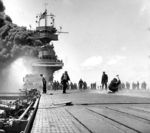
Just after midnight on June 4, Admiral Nimitz, based on patrol plane reports, advised Task Forces 16 and 17 of the course and speed of the Japanese "main body," also noting their distance of 574 miles from Midway. Shortly after dawn, a patrol plane spotted two Japanese carriers and their escorts, reporting "Many planes heading Midway from 320 degrees distant 150 miles!"
The first attack, however, took place when the four night-flying PBYs attacked the Japanese transports northwest of Midway with one PBY torpedoing fleet tanker Akebono Maru. Later that morning, at roughly 0630, Aichi D3A ("Val") carrier bombers and Nakajima B5N ("Kate") torpedo planes, supported by A6M fighters ("Zekes"), bombed Midway Island installations. Although defending U.S. Marine Corps Brewster F2A ("Buffalo") and Grumman F4F ("Wildcat") fighters suffered disastrous losses, losing 17 of 26 aloft, the Japanese only inflicted slight damage to the facilities on Midway. Motor Torpedo Boat PT-25 was also damaged by strafing in Midway lagoon.
Over the next two hours, Japanese "Zekes" on Combat Air Patrol (CAP) and antiaircraft fire from the Japanese fleet annihilated the repeated attacks by the American aircraft from Marine Corps Douglas SBD "Dauntless" and Vought SB2U "Vindicator" scout bombers from VMSB-241, Navy Grumman TBF "Avenger" torpedo bombers from VT-8 detachment, and U. S. Army Air Force torpedo-carrying Martin B-26 "Marauder" bombers sent out to attack the Japanese carriers. Army Air Force B-17s likewise bombed the Japanese carrier force without success, although without losses to themselves.
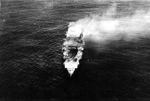
Between 0930 and 1030, Douglas TBD "Devastator" torpedo bombers from VT 3, VT-6, and VT-8 on the three American carriers attacked the Japanese carriers. Although nearly wiped out by the defending Japanese fighters and antiaircraft fire, they drew off enemy fighters, leaving the skies open for dive bombers from Enterprise and Yorktown. VB-6 and VS-6 "Dauntlesses" from Enterprise bombed and fatally damaged carriers Kaga and Akagi, while VB-3 "Dauntlesses" from Yorktown bombed and wrecked carrier Soryu. The submarine USS Nautilus (SS-168) then fired torpedoes at the burning Kaga but her torpedoes did not explode.
At 1100, the one Japanese carrier that escaped destruction that morning, Hiryu, launched "Val" dive bombers that temporarily disabled Yorktown around noon. Three and a half hours later, Hiryu's "Kate" torpedo planes struck a second blow, forcing Yorktown's abandonment. In return, "Dauntlesses" from Enterprise mortally damaged Hiryu in a strike around 1700 that afternoon. The destruction of the Carrier Strike Force compelled Admiral Yamamoto to abandon his Midway invasion plans, and the Japanese Fleet began to retire westward.
During the battle, Japanese destroyers had picked up three U.S. naval aviators from the water. After interrogation, however, all three Americans were murdered. One TBD pilot, Lieutenant George Gay escaped detection by the Japanese ships and was later rescued by a PBY.
June 5, 1942[edit]
On June 5, TF 16 under command of Rear Admiral Spruance pursued the Japanese fleet westward, while work continued to salvage the damaged Yorktown. Both Akagi and Hiryu, damaged the previous day, were scuttled by Japanese destroyers early on the 5th.
June 6, 1942[edit]
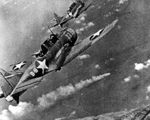
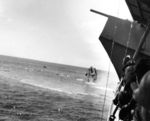
The last air attacks of the battle took place on June 6 when dive bombers from Enterprise and Hornet bombed and sank heavy cruiser Mikuma, and damaged destroyers Asashio and Arashio,as well as the cruiser Mogami. At Admiral Spruance's expressed orders, issued because of the destruction of three torpedo squadrons on June 4, "Devastators" from VT-6 that accompanied the strike did not attack because of the threat to them from surface antiaircraft fire. After recovering these planes, TF 16 turned eastward and broke off contact with the enemy. COMINT intercepts over the following two days documented the withdrawal of Japanese forces toward Saipan and the Home Islands.
Salvage operations had commenced onboard Yorktown when the Japanese submarine I-168 interrupted; torpedoes were fired at her as well as the destroyer tending Yorktown, USS Hammann (DD-412), which sank within minutes. Screening destroyers depth-charged I-168 but the Japanese submarine escaped destruction. Yorktown, suffering from numerous torpedo hits, finally rolled over and sank at dawn on June 7.
Aftermath and Significance of the Battle[edit]
On June 9, submarine USS Trout (SS-202) rescued two survivors from sunken Japanese heavy cruiser Mikuma. Ten days later the seaplane tender USS Ballard (AVD-10) was directed by a PBY to the site where Hiryu crewmen were in the water. The tender rescued 35 Japanese survivors who, as members of the engineering department deep in the ship, had been left for dead in the abandonment of the carrier. On June 21, a PBY from VP-24 rescued two men from an Enterprise TBD about 360 miles north of Midway. These were the last survivors of the Battle of Midway to be recovered.
Thanks to American signals intelligence, judicious aircraft carrier tactics, and more than a little luck, the U.S. Navy had inflicted a smashing defeat on the Japanese Navy. Although the performance of the three American carrier air groups would later be considered uneven, their pilots and crew had won the day through courage, determination, and heroic sacrifice. The Japanese lost the four large carriers that had attacked Pearl Harbor, while the Americans only lost one carrier. More importantly, the Japanese lost over one hundred trained pilots, who could not be replaced. Recognizing this defeat for what it was, Admiral Nagumo's Chief of Staff later wrote: "I felt bitter… I felt like swearing." In a larger strategic sense, the Japanese offensive in the Pacific was derailed and their plans to advance on New Caledonia, Fiji, and Samoa postponed. The balance of sea power in the Pacific shifted from the Japan to an equity between America and Japan. Soon after the Battle of Midway the U.S. and their allies would take the offensive in the Pacific.
References[edit]
- United States Navy official battle reports
- Fuchida, Mitsuo. Midway: The Battle that Doomed Japan, the Japanese Navy's Story, Naval Institute Press, Annapolis, MD (1955)
- Parshall, Jonathan, and Tully, Anthony. Shattered Sword: The Untold Story of the Battle of Midway, Potomac Books, Dulles, VA (2005)
- Prange, Gordon W. Miracle at Midway, McGraw-Hill, New York (1982)
- Director John Ford's documentary of the battle
| Copyright Details | |
| License: | This work is in the public domain in the United States because it is a work of the United States Federal Government under the terms of Title 17, Chapter 1, Section 105 of the US Code. |
| Source: | {{{source}}} |
| This image may not be freely used on user pages. | |
| If you think this image is incorrectly licensed you may discuss this on the image's talk page. | |
Categories: [World War II Battles]
↧ Download as ZWI file | Last modified: 02/08/2023 01:42:43 | 5 views
☰ Source: https://www.conservapedia.com/Battle_of_Midway | License: CC BY-SA 3.0
 ZWI signed:
ZWI signed: KSF
KSF